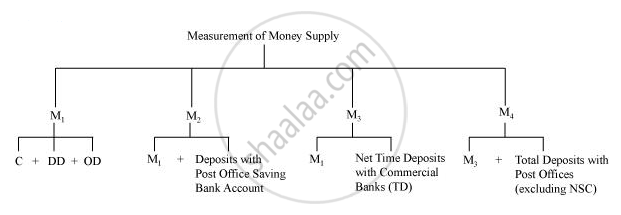Advertisements
Advertisements
प्रश्न
What are the alternative definitions of money supply in India?
उत्तर
The various definitions of money supply in India as prescribed by RBI are M1, M2, M3 and M4.
M1, M2, M3 and M4 are arranged in the descending order of liquidity. In other words, M1 has the highest liquidity and M4 has the least liquidity.
So,
M1 = C + DD + OD
Where,
C = Currency held by public
DD = Net demand deposits of the bank
OD = other deposits held by RBI
M2 = M1 + Savings of the people with Post offices (M2 includes the components of M1 as well as the savings of people with Post office.)
M3 = M1 + Net time deposits with commercial banks (M3 is the most commonly used measure of money supply. It includes the components of M1 and net time deposits of commercial banks.)
M4 = M3 + Total deposits with post offices (excluding National Saving certificate)
All these definitions of money supply in India are represented in the flow chart given below.

APPEARS IN
संबंधित प्रश्न
State the meaning and components of the money supply.
Answer the following question.
State any two components of the M1 measure of the money supply.
The RBI Headquarters is located in ______.
The basic distinction between M1 and M2 is with regard to.
MV stands for the ______.
What is money supply?
What are the determinants of money supply?
One of the measures of the money supply is ______.
Cash balance approach in Quantity theory emphasis on ______.
Money supply in India may increase if, ______
- Reserve Bank of India (RBI) injects more money in circulation.
- The commercial banks expand their credit operation.
- Tax rates are reduced by the Central Government.
- Reserve Bank of India increases the Bank Rate.
Read the following statements carefully:
Statement 1: Money supply (M1) in India does not include ‘demand deposits’ with commercial banks.
Statement 2: Money supply (M1) refers to, assets available with the Commercial Banks during a particular period of time.
In the light of the given statements, choose the correct alternative.
